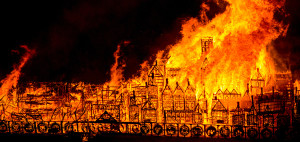 The 17th century was a grim time to be born poor in the city of London. Life expectancy on-average was to the age of 35. The East End of London was populated by the poor, who lived in wooden houses sealed with pitch (a black glue-like substance left behind when coal tar is heated or distilled). The houses were built atop one another, with the upper structure leaning over the narrow lanes, making it a dark, dank place to live. Windows were linen soaked in linseed oil as a light source. Human and animal waste, garbage and dirty water from small shops were dumped into the lanes where people walked and children played. Food was another item that was sparse – the mainstay was bread, cheese and onions. Most lived on pottage – a mix of boiled grain and vegetables, if they could find some. It was a harsh life but one made even harder by the Black Plague. During the 17th century, the Black Plague broke out three times (1603, 1636 and 1665). But, within a year after the last bout of the Plague, on September 2, 1666, a huge fire broke out. It is known as the Great London Fire. All the fuel was available – wood and pitch housing, garbage piled in the streets, straw in the houses and on the lanes, candles for light, and no water available to fight such a large blaze. Thomas Farriner was the King’s baker, and he had a bakery shop on Pudding Lane. It was his maid that was careless and did not completely extinguish the fires in the ovens that night. After the overheated ovens began to spark in the wooden structure, the rest is history. The only materials to fight the fire were leather buckets and hooks to tear the flaming buildings down. London was basically built of wood, and the weather was dry and windy, which made things even worse. It raged from September 2nd through September 5th. King Charles II took charge and tried to make fire breaks by tearing down buildings in its path. Finally, they had to call in the Navy to blast the area to stop the fire. All told, there were approximately 13,000 dwellings and some 400 streets destroyed. London was rebuilt, but with more safety issues attended to and observed. After the fire, the Black Plague never returned to London. Many say it was the killing of the rats and fleas in the fire, and the fact that the heat from the fire caused the Fleet and Thames rivers to boil, ridding it of foul garbage and disease. So, out of bad came good – or as my grandma always said: “When the Lord shuts a door, he always opens a window!”
The 17th century was a grim time to be born poor in the city of London. Life expectancy on-average was to the age of 35. The East End of London was populated by the poor, who lived in wooden houses sealed with pitch (a black glue-like substance left behind when coal tar is heated or distilled). The houses were built atop one another, with the upper structure leaning over the narrow lanes, making it a dark, dank place to live. Windows were linen soaked in linseed oil as a light source. Human and animal waste, garbage and dirty water from small shops were dumped into the lanes where people walked and children played. Food was another item that was sparse – the mainstay was bread, cheese and onions. Most lived on pottage – a mix of boiled grain and vegetables, if they could find some. It was a harsh life but one made even harder by the Black Plague. During the 17th century, the Black Plague broke out three times (1603, 1636 and 1665). But, within a year after the last bout of the Plague, on September 2, 1666, a huge fire broke out. It is known as the Great London Fire. All the fuel was available – wood and pitch housing, garbage piled in the streets, straw in the houses and on the lanes, candles for light, and no water available to fight such a large blaze. Thomas Farriner was the King’s baker, and he had a bakery shop on Pudding Lane. It was his maid that was careless and did not completely extinguish the fires in the ovens that night. After the overheated ovens began to spark in the wooden structure, the rest is history. The only materials to fight the fire were leather buckets and hooks to tear the flaming buildings down. London was basically built of wood, and the weather was dry and windy, which made things even worse. It raged from September 2nd through September 5th. King Charles II took charge and tried to make fire breaks by tearing down buildings in its path. Finally, they had to call in the Navy to blast the area to stop the fire. All told, there were approximately 13,000 dwellings and some 400 streets destroyed. London was rebuilt, but with more safety issues attended to and observed. After the fire, the Black Plague never returned to London. Many say it was the killing of the rats and fleas in the fire, and the fact that the heat from the fire caused the Fleet and Thames rivers to boil, ridding it of foul garbage and disease. So, out of bad came good – or as my grandma always said: “When the Lord shuts a door, he always opens a window!”
Previous ArticleWalcott 2017!
Next Article Time 2 Have A Nice 1
SharLeigh
SharLeigh has an inquisitive nature – she is interested in current events, history, science and many more subjects, including things that go bump in the night! Since 1997, SharLeigh has scoured the internet, looking for interesting, fun and timely topics covering all sorts of human-interest subjects for her articles from her home in Fontana, CA.
